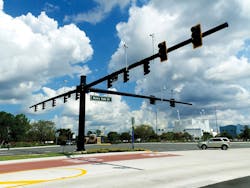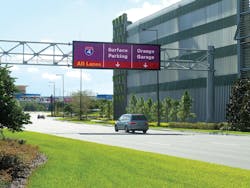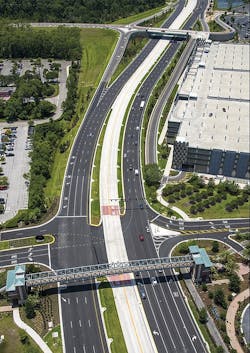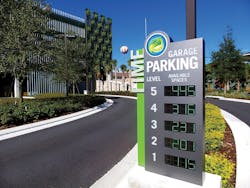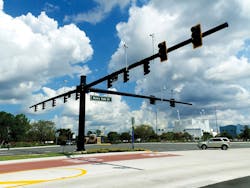The magic of road building
The goal of every road project is to get motorists to their destinations safely and efficiently. But getting tourists, employees and residents in and out of a major theme park and its environs requires some engineering and construction magic all its own.
HNTB Corp. and the Reedy Creek Improvement District partnered to do just that with a 1.6-mile section of Buena Vista Drive, a project ultimately completed a month ahead of schedule and ahead of the opening of the expanded and rebranded Disney Springs, a premiere shopping, dining, and entertainment center in greater Orlando’s resort area, adjacent to Walt Disney World.
The Buena Vista Drive project posed several unique challenges. It is heavily used by buses and tourists with up to 65,000 vehicles per day on peak days. The Disney footprint has centralized parking and separate bus entrances. But Buena Vista Drive, originally built in 1975, services multiple destinations, including Typhoon Lagoon water park, Disney administrative offices and Disney Springs, said John Hornbeck, P.E., vice president of HNTB and project manager for the corridor.
One of the main concerns was the amount of bus and passenger vehicle interactions as the area grew in the 40 years since Buena Vista Drive was built.
“Buses have to come in from all the different resort and hotel areas, and be able to get into Disney Springs and drop people off and get out,” Hornbeck said.
Overhead full-color LED dynamic message signs direct traffic with real-time information. Photos: Aerial Innovations, Courtesy of Reedy Creek Improvement District.
Older Buena Vista Drive expansions and revisions had resulted in multiple entrances with vehicle and bus interaction occurring at no less than seven closely spaced signalized intersections along the corridor. The ongoing plan to improve Buena Vista Drive will simplify access by serving three new parking structures for passenger vehicles and providing median bus lanes to a new bus facility in the middle of Disney Springs that collectively will improve safety and traffic flow. The project’s featured innovative technology and design included three-arm mast traffic signals, use of PTV Vissim modeling software, “smart” garages that can tell motorists where available parking spaces are located or if the garage is full, dedicated concrete bus lanes in the median of the road, and overhead full-color LED dynamic message signs. Project officials also used 3-D design models to convey design intent at Integrated Concurrent Engineering, or ICE, meetings among stakeholders, as the complex project required coordination across 10 related projects. The use of ICE, which was pioneered by NASA, allowed critical decisions to be made more quickly, thus reducing project costs and delays. The concrete bus lanes also include traffic separators between them and the asphalt general-use lanes.
“The bus lanes were built of concrete because it wears better for heavier vehicles,” Hornbeck added. “By putting the buses on concrete and isolating them on concrete, maximum service life can be achieved from the road.”
Enhanced roadway signs and red-colored concrete were used at the access points to alert all users of the dedicated bus lanes. The lighter-colored concrete and signing serve as a reminder to passenger vehicle drivers to stay on the black asphalt and off the dedicated bus lanes.
The project also included pedestrian bridges to reduce the conflict between pedestrians and drivers along the widened Buena Vista Drive. Currently there are two pedestrian bridges with a third being built, Hornbeck said. The bridges provide safe access not only for tourists unfamiliar with the area, but also for employees of Disney Springs and other resort businesses. Those employees often park in lots across the corridor.
“It takes pedestrians off the roads and out of the signal cycle as well,” Hornbeck said. “Drivers don’t have to wait for pedestrians to cross.”
Intelligent signage ahead
Another safety feature are full-color overhead dynamic message signs, or DMS. The signs provide real-time information on road conditions and parking. That real-time information is made possible by the project’s unseen safety feature: the Reedy Creek Improvement District’s traffic operations center.
The center was built to operate the corridor “and watch its operation and tweak it as we need to,” said Kathryn Boes Kolbo, P.E., manager of the planning and engineering division for the district. “For an agency
our size, we have this incredibly advanced center that has a 12-ft wall of screens [that show] our cameras at every intersection to see how traffic is moving. We have real-time control of those signals if we need to change signal timing.”
If the operations center sees a car blocking the road, DMS alerts can be placed along the roadways, Kolbo said.
The project also included parking garages featuring overhead trusses with DMS signs. Each parking spot uses a detection device to monitor occupancy and an LED indication light at each space shows motorists whether the space is available. The lights can be seen from the aisles to facilitate finding an open space. Additionally, signs at the parking garage entrance show how many available parking spaces there are on each floor.
“We can override the parking garage centers’ signals if we need to,” Kolbo said. “It allows us to keep a finger on the pulse of everything going on along this road.” With upwards of 65,000 vehicles per day on Buena Vista Drive, that is no small feat. “We move so much traffic and move so many people. There is always something we don’t expect, and we have the ability to morph and change and react to that unexpected event as it happens. To me, that’s what is the new space-age technology.”
The new roads also have sensors embedded in the pavement that communicate with receivers hung from traffic signal poles, Hornbeck said. The sensors count traffic in real time, and that information is fed to the operations center as well. The traffic signal poles themselves are unique in that they are three-mast arms placed in the medians, rather than the traditional two-mast arms at intersection corners. And traffic signals are synced to help with traffic throughput.
“Smart” garages direct traffic to preferred floors and even specific open parking locations.
Visitors to and residents of central Florida are soon familiar with the area’s torrential rainfall, particularly during summer and fall afternoons.
“We provided 4-6 ft of extra width,” Hornbeck said. “That’s unique to this road and to Florida.”
With the region’s heavy downpours, water tends to pond on the roadways “and this road historically has had some problems,” Hornbeck added. “It has been widened over the years, and flooding had become an issue.”
To accommodate the water spread, a paved shoulder, inlets and trench drains were built with cleanout access to facilitate future maintenance. Essentially, the road is “ready for the next couple of decades,” Hornbeck said.
That zero-spread design feature was a top priority for Reedy Creek officials, Kolbo said. “Most drivers here are not from central Florida. They don’t understand these rainfalls and don’t understand how a vehicle handles on those wet roads. We wanted to make sure the road was not going to store this water. That safety feature was very important to us.”
The corridor also handles multiple peak times. Unlike typical urban and suburban roads that have morning and evening rush hours for commuters, Buena Vista Drive also handles an evening peak with visitors to Disney Springs and a late-night peak when the theme parks close, Kolbo said. “We have Disney Springs. We have offices along this corridor. Because we have competing uses, we have some unique traffic patterns.”
Putting it all together
With a project of this scale, construction conflicts could have been a major issue, but stakeholders worked together to ensure a smooth flow.
Vissim and 3-D modeling, used to show stakeholders and non-engineers what the project would eventually look like, forged the eventual project partnership, said George Gilhooley, P.E., East Florida office leader for HNTB.
PTV Vissim is a microscopic multimodal traffic flow simulation software package developed by PTV Planung Transport Verkehr AG, of Karlsruhe, Germany.
“Vissim is a great technical tool that allows you to model multiple vehicle types, such as buses and passenger vehicles,” Gilhooley said. “And the equal value of Vissim is its ability to demonstrate how the highway will look and how it will operate at different stages of the design.”
The software allows designers to show various alternatives for the road, and why a particular alternative is best.
“What makes this project special and important is the way we’ve integrated all the different needs,” Reedy Creek’s Kolbo said. “It’s a very old road. We’ve widened it several times. We didn’t just look at one piece of it. We tried to optimize each piece of it.”
The widened road allows privately owned vehicle access through the corridor, and the dedicated bus lanes allow those users to move rapidly and smoothly through the corridor.
“We pulled all the stakeholders together to see what they needed and wanted, and optimized those needs to meet safety, guest satisfaction and traffic,” Kolbo said. “It’s easy to address one aspect or another, but sometimes you have competing needs. What made this project special and successful was the attempt to integrate all those competing needs.”
The project was really “a balance between mobility and safety,” Gilhooley said. “It’s a holistic approach to a corridor and a demonstration of the district’s thoughtful approach.”
And the road had to stay open and operational during construction, Kolbo pointed out. “Guest satisfaction is always a priority in our minds. We didn’t want people to have a bad experience. We worked very hard to meet the immediate need while we were constructing the ultimate road.
